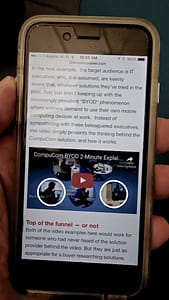Perhaps the most powerful driver of “digital transformation” has been the smart phone. And perhaps the most notable “transformation” as been the rise of video as a tool for discussion and social interaction.
In a wide-ranging report, The Future of Video, Feng Li of London’s Cass Business School, writes that “video is not simply an important part of the online experience increasingly — video is the internet.” Yet, he writes, “most consumption of online video remains very similar to watching TV via the internet.”


Virtual Reality video, which I wrote about recently, does provide a new kind of video experience for mobile viewers — made possible by the compass built into your smart phone — that is very different from linear video. It’s increasingly popular, as evidenced by the growing number of VR videos on YouTube.
Interactive video for tech marketing: pity the salesperson
Another type of video experience new to most smart phone users is “interactive” video where the viewer can take charge of the video experience by clicking objects on the screen. That’s not quite as natural as just looking around, as you do with VR. But it forces you to think. Though much-used in eLearning, interactive video has been widely ignored by marketers for more than a decade. That may be about to change.
Why? Well, up to now, interactive video has not been easy to deliver on the iPhone. You needed to create an app — and get the viewer to download it. That’s fine for eLearning, where the viewer is motivated (or required) to learn. But for consumer or B2B buyers, it’s not very practical.
Put yourself in the place of a salesperson trying to get a prospect to interact with a video that contains clickable chapters or other opportunities to choose content. If you send a link to that video via email, there’s a high probability that the email (and its links) will be viewed on a mobile device. And, if it’s an iOS device, Apple’s QuickTime app will take over from the browser to display the video — but none of the clickable objects.
Will a buyer be motivated to download an app to be marketed to? Not likely.
Inline interactive video in iOS 10
The big news is that 100 million mobile web users on iOS devices will have seamless access to interactive video starting now, with the release of iOS 10. As they scroll through their email and social media feeds, the clickable, branch-able, changeable video will simply be there, part of the online landscape.

Here’s the thing: it’s not technically hard to make any video interactive. It takes some imagination and skill to do it effectively, but, technically, it’s amazingly easy.
What has been very hard is to distribute an interactive video at scale. I believe this is going to have a huge impact on the future of tech marketing video. As Feng Li points out, online video is increasingly a tool for discussion and as a way to interact with the creators and with each other in communities. Interactive video, with the ability to capture and respond to user input within the video, will change the experience for the user. It’s a big opportunity for marketers to connect.




